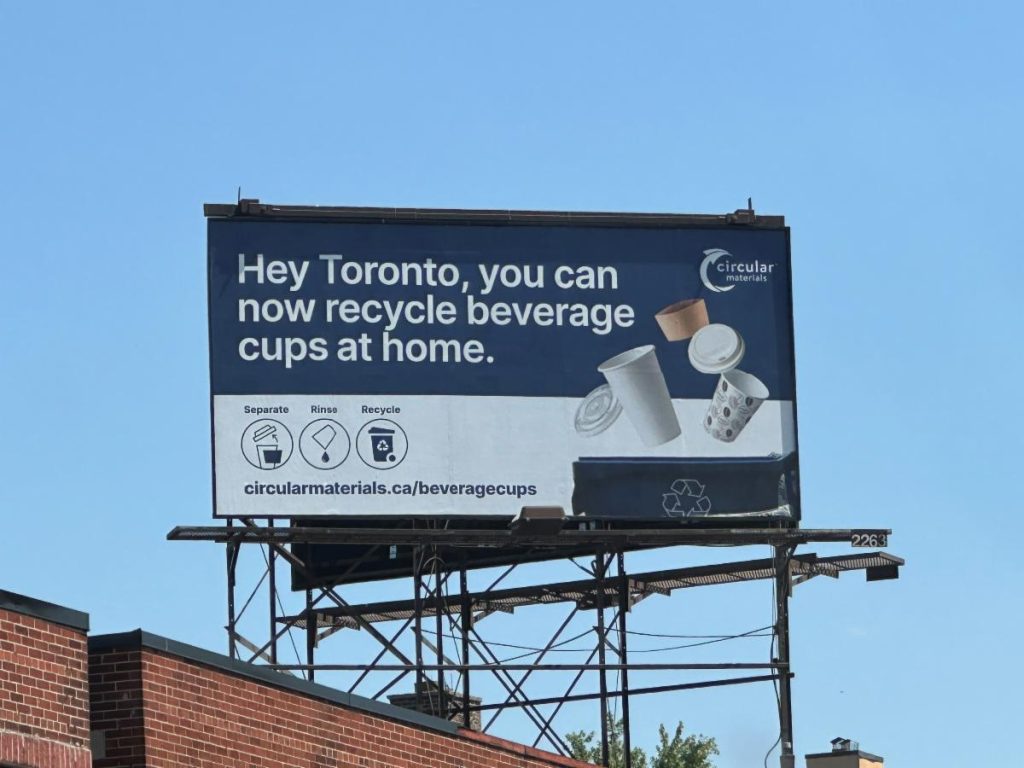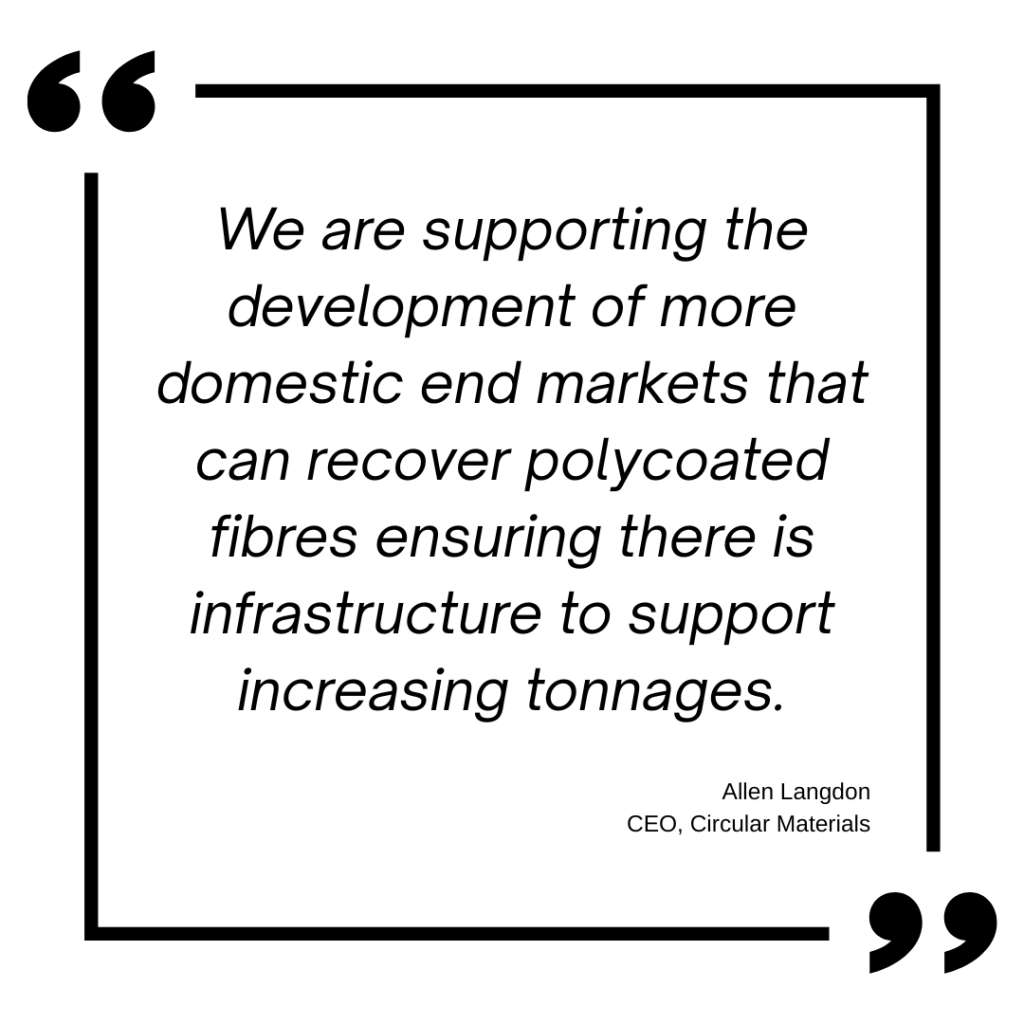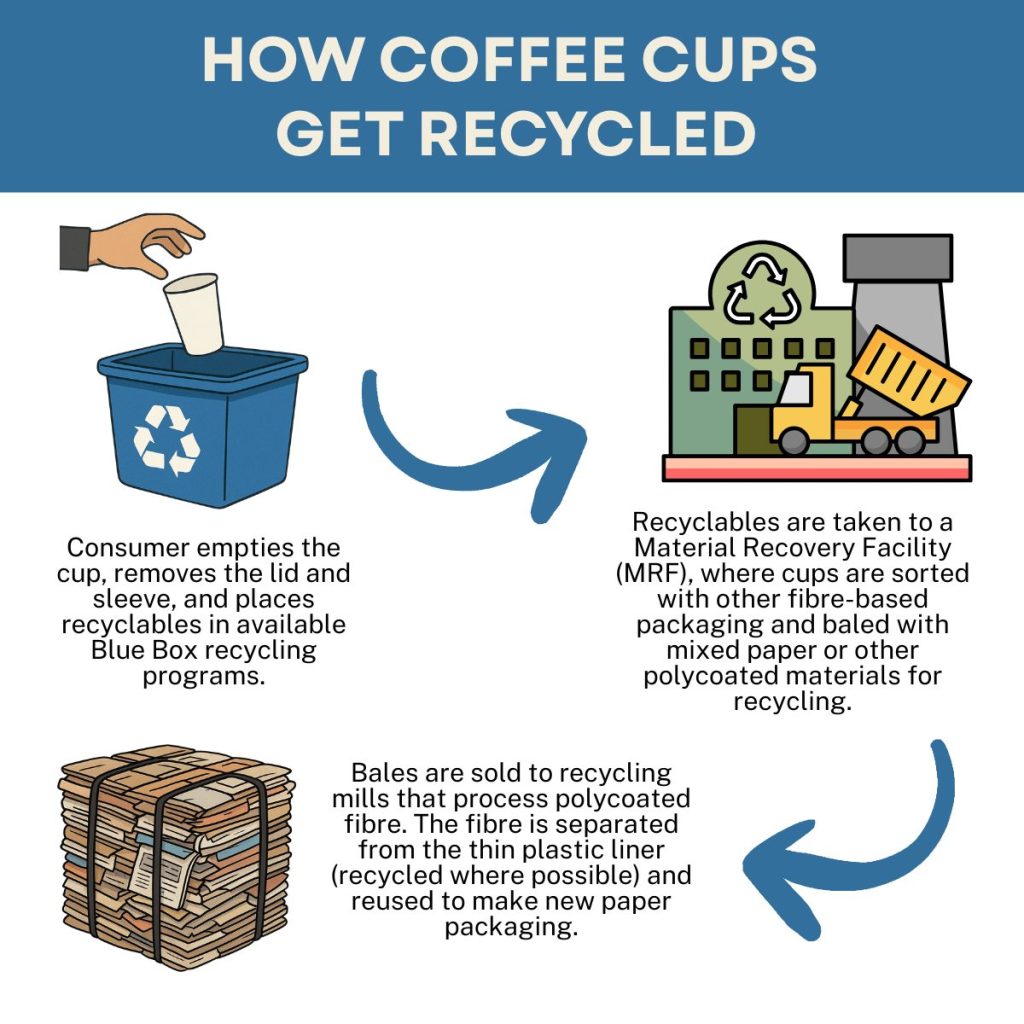Recycling takeaway coffee cups has long been a challenge. Most are made from paperboard lined with a thin layer of plastic or polyethylene to resist liquids, and this lining can make it more difficult to process in recycling systems. As a result, cups have often been excluded from municipal curbside recycling programs.
But that’s beginning to change with the move to Extended Producer Responsibility (EPR), where producers become financially and operationally responsible for recycling. Many Canadian provinces are introducing, or transitioning to, full EPR programs, which includes rethinking how certain types of packaging are collected, processed, and ultimately recycled – starting with the takeaway coffee cup.
While hot cups represent less than 1% of Toronto’s residential waste stream,[1] they have become symbolic of the challenges and opportunities of recycling. They are a multi-material item that reflects both a culture that prioritizes consumer convenience, and the need for systems that can separate and recover more complicated packaging. The coffee cup also highlights how producers are beginning to evolve recycling in Ontario under an EPR approach.
Circular Materials – a producer responsibility organization (PRO) that that helps producers meet their obligations under packaging EPR regulations across Canada, and the administrator of Ontario’s new common collection system – recently announced it will launch a harmonized list for recycling, including new materials like coffee cups, across Ontario in 2026 as the fully transitioned system officially rolls out.
This follows Circular Materials’ pilot, launched in Toronto in July 2024, to recycle hot and cold beverage cups, which marked the first step toward incorporating these new materials in recycling systems across Ontario.
To explore the pilot’s goals, progress, challenges, and opportunities, PPEC spoke with Allen Langdon, CEO of Circular Materials. This interview has been edited for length.
Q. What is the goal of the Toronto cup pilot project?
The goal of the beverage cup pilot is to significantly reduce the amount of waste generated and support the development of a proactive approach to managing recyclable materials and enhancing overall recycling efficiency across Ontario. This pilot enabled us to develop the necessary infrastructure and processing abilities to increase recovery of the material and raise awareness with Toronto residents.
Q. Now that the pilot has been underway for over a year, what can you share about its progress?
The pilot has been positive and resulted in an increase in recycling of beverage cups in Toronto. Residents were excited to be able to recycle their beverage cups at home as convenience and accessibility is key to driving recycling.
Q. Has Circular Materials gathered any data so far — such as capture rates, contamination issues, or end markets for the material?
Inbound audit comparisons reflect an increase of 12% in single-sided and double-sided polycoat categories, which include hot and cold beverage cups.
Q. What are some of the challenges or barriers Circular Materials has identified through the pilot?
Prior to the launch of the pilot, Circular Materials worked with our end markets that purchase baled material from us to ensure that the beverage cups would be properly recovered. It was determined that they contain valuable fibre and mills that are equipped to manage polycoated material did not have an issue recovering the cups.
From a consumer behaviour perspective, more awareness through promotion and education initiatives will be critical to drive more of this material to the recycling stream.
Q. Are there any lessons learned as other jurisdictions look to expand cup recycling as part of EPR expansion?
From a recovery perspective, we will continue to consult with our end markets to ensure the proper recovery of any new materials. This also prevents any surprises in changes to bale compositions and properly determining the value of the recycled commodities that we market.
From a promotion and education-perspective, out of home (e.g. billboards, transit shelters, etc.) was determined to be the most successful communication tactic from the channels that were leveraged during the pilot.

Q. How are you engaging residents to ensure the cups are being properly prepared (e.g., empty, rinsed, sleeves removed)?
Advertising efforts were tailored by target audiences and ensured high impact/visible mediums that only targeted Toronto residents. Results indicated that out of home billboards were very effective channels in high density and multi-family populated areas, with geo-targeted social media and digital display ads the second most effective.
Q. While Extended Producer Responsibility puts the onus on producers, success relies on the whole system, from consumers to haulers to mills. How do you see the role of shared responsibility playing out in making beverage cup recycling successful?
Come 2026, hot and cold beverage cups will be accepted province-wide, allowing Circular Materials to use its robust promotion and education program to widely educate residents on this newly accepted material. The promotion and education efforts, over time, will increase the amount of material coming into the system.

Q. Is there anything else you’d like to share about the pilot, the future of beverage cup recycling, or how stakeholders can support broader system success that we haven’t covered?
We are supporting the development of more domestic end markets that can recover polycoated fibres ensuring there is infrastructure to support increasing tonnages. Broader system success relies on many levers – resident participation for increasing capture rates, PCF [post consumer fibre] technology and processes to meet required sorting efficiency rates and responsible end markets that yield the highest possible recovery.
This pilot also offered learnings on the addition of new materials in collection and represents a major step forward in our mission to enhance recycling processes and efficiency. By collaborating on projects like this, we can improve recycling outcomes, create new efficiencies, and meet performance targets. This pilot not only expands the range of recyclable materials accepted in Toronto but also sets the stage for broader recycling advancements across Ontario.

Building Momentum Across the Recycling Value Chain
Efforts to improve paper cup recycling in Ontario are a strong example of producers taking responsibility and will help inform advancing cup recycling in other jurisdictions. Momentum is building as different players across the recycling value chain collaborate to make cup recycling more effective.
The NextGen Consortium and Foodservice Packaging Institute have been working together to increase paper cup recycling through consumer education and securing end-market acceptance — with more than 40 North American mills now accepting single-use PE-coated cups in bales of mixed paper or polycoat cartons and aseptic packaging.
And recently, the Recycled Materials Association (ReMA) added paper cups to its North American residential recycling specifications, an important step toward greater consistency in collection and processing, and toward strengthening end markets for recyclable materials like paper cups.
As EPR continues to evolve, we hope to see more recovered materials, including cups and ultimately other foodservice packaging items, reprocessed into new products, ultimately improving waste diversion and recycling rates in Canada.
[1] According to the report Towards a Sustainable Coffee Cup Culture: A Comprehensive Framework for Preventing Paper Cup Waste in Toronto, by Daniela Palma (York University, July 2024) the estimated total weight of hot beverage paper cups generated in Toronto’s single-family and multi-family households is approximately 2,288.26 tonnes per year. According to the City of Toronto’s 2024 Residential Diversion Rates, the City managed more more than 725,000 tonnes of residential waste from single-family homes (houses) and multi-residential buildings (apartments, condos and co-ops with nine or more units that receive City collection). Dividing 2,288 by 725,000 equals 0.3 per cent.
This calculation is provided for illustrative purposes only, reflects Toronto-specific data, and is based on the best available information, which may not be representative of Ontario as a whole.
